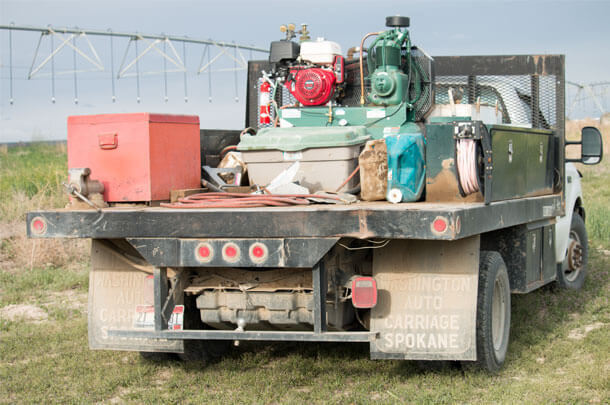As our operation has grown in size and complexity, so has the necessity to become more organized and efficient regarding repairs and maintenance of existing and new facilities and equipment. Along with learning new skills and practicing old ones, we find ourselves trying harder to keep track of the tools needed for these day-to-day tasks.
In 1996 we found ourselves expanding and taking on more farm ground – a piece of land some 15 miles removed from our home base. As we began to tend to this addition, I found myself making numerous trips home for tools, irrigation parts, fence materials, equipment parts, fuel – the list goes on and on.
At some point, midway through that first crazy summer, Bill Jensen, a well-seasoned veteran to farming and owner of a neighboring farm near Tendoy, Idaho, said, “Sonny, all that running around you’re doing for that broke-down place is going to break you. Get everything you know you might need and put it in one pickup, and leave it there. You’ll be surprised how much that will save you, and how much more you’ll get done in a day.”
I took the old timer’s words to heart, went home, took the rear seat out of an extended-cab Ford three-quarter-ton pickup that I had been using to haul fuel to my equipment, and loaded tool boxes, buckets filled with various wrenches, hammers, pliers, drills, saws and miscellaneous parts into the space where the seat used to be. In the bed of the pickup, behind the 100-gallon diesel transfer tank, I loaded a 4500-watt generator and a plastic storage trunk containing a wire-feed welder, and supplies. My first farm field-service truck was born.
Over the ensuing years – with the addition of more distance between properties, custom haying and fencing operations, and the never-ending work at home – the list of tools has expanded and the old Ford pickup with the standard bed has been replaced with a Dodge flatbed with tool boxes under the bed, making room for more and larger tools on the deck. Through it all there has rarely been a day that I have not been rewarded for taking Jensen’s advice.
Recently I was talking to my son-in-law, Gregory Eppich, farmer and dairy producer near Handel, Saskatchewan, about different ways to set up a service truck and he said, “Most of our facilities are built with pipe recycled from the oil fields, so I built a skid platform with a 1/4-inch steel deck and mounted my welder on that. I built some trays on the platform to hold a few tools, welding supplies, things like that, and I mounted a vice in one corner of the platform. I lift it on and off of my service truck with a skid steer. When I’m working on the pens, I carry it around with the skid steer. That way I can get into tight places the truck won’t go, and places you’d bury a pickup.”
If you are thinking about putting together a service truck, there are a few things to consider. Will the truck ever leave the farm? Do I need to turn the key and start the truck in cold weather? Will I need to pull a trailer with this truck? If so, what kind – bumper pull, gooseneck?
I am currently using an extended-cab heavy-duty three-quarter-ton diesel with a flatbed, and for the most part, I am pleased with its performance. I have to pay attention to make sure I have treated the fuel before cold weather hits, and plug it in for a couple hours on cold days.
Next take a minute and make a list of the type of repairs and new installations, in the field or yard, you have performed over the past six months to a year. This will help you put together a value on a mobile service truck estimate when you consider how much time you or the help spent gathering the tools and putting them away for each of these jobs. Don’t forget that your time has a monetary value.
Now determine what you need to have on the truck. From the list of repairs and new installations, generate a quick list of the tools you used on each job. Is it a big list? The key is in how you organize the truck. Even though I have a pretty well set up flatbed these days, I still use the area behind the front seats of the extended cab and store many tools and parts there to keep them out of the weather. To maximize open space on the deck and behind the front seats, I use a combination of square buckets, military surplus ammo cans and various plastic and steel cargo boxes.
You need to set up your service truck so that it works best for you, but one last note on setting it up to work efficiently, organize the tools and parts by like kind, and make a note as to the contents on the outside of the containers. This will make your life much easier on the job as you will waste less time looking for the tools you need. ![]()

-
Michael J. Thomas
- Freelancer, stock producer and farm mechanic
- Salmon, Idaho
- Email Michael J. Thomas
PHOTO: Service trucks can save miles of driving and valuable time chasing down the right tools, but they're only as convenient as you organize them to be. Photo by Lynn Jaynes.













